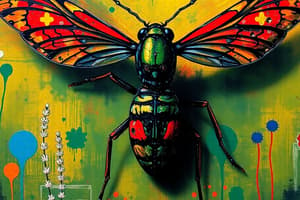Podcast
Questions and Answers
What are the two subtypes of Oligopod larvae?
What are the two subtypes of Oligopod larvae?
Campodeiform and Scarabaeiform
Which type of larvae is generally predators and very active?
Which type of larvae is generally predators and very active?
Campodeiform
Describe the characteristics of Scarabaeiform larvae.
Describe the characteristics of Scarabaeiform larvae.
Stout, subcylindrical body with short thoracic legs and absence of caudal processes.
What are the characteristics of Polypod or Eruciform larvae?
What are the characteristics of Polypod or Eruciform larvae?
Which type of larvae are without legs?
Which type of larvae are without legs?
What is the pupal stage in holometabolous insects?
What is the pupal stage in holometabolous insects?
Describe Obtect pupae.
Describe Obtect pupae.
What characterizes Exarate pupae?
What characterizes Exarate pupae?
How many types of pupae are there?
How many types of pupae are there?
Flashcards are hidden until you start studying
Study Notes
Egg Laying
- Eggs can be laid in groups, with different species exhibiting unique characteristics
- Pedicellate eggs are laid on plants in silken stalks, around 1.25 mm in length (e.g., green lacewing)
- Barrel-shaped eggs are deposited in compact masses (e.g., stink bug)
- Ootheca is a brown, chitinous capsule containing eggs, laid by cockroaches
- Egg pods are formed by grasshoppers, which secrete a frothy material that encases the eggs
- Egg cases or oothecae are formed by mantids, which deposit eggs on twigs in a foamy secretion called spumaline
- Egg masses are laid by moths, with eggs stuck together with body hairs (e.g., rice stem borer)
- Egg rafts are formed by Culex mosquitoes, consisting of 200-300 eggs laid in water
Larval Stage
- The larval stage is the active growing stage, differing radically from the adult stage
- There are four main types of insect larvae: protopod, oligopod, polypod, and apodous
- Protopod larvae have little yolk, and abdominal segmentation is absent (e.g., endoparasitic Hymenoptera)
- Oligopod larvae have thoracic legs and are further divided into campodeiform and scarabaeiform types
- Polypod or eruciform larvae have three pairs of thoracic legs and up to five pairs of unjointed abdominal legs or prolegs (e.g., caterpillars)
- Apodous larvae are without legs (e.g., house fly larvae)
Nymphs and Metamorphosis
- Nymphs are young ones of lower orders, resembling adults except for wings and reproductive organs
- Larvae are young ones of higher orders, differing from adults in appearance and growth
- There are three types of metamorphosis: ametabola, hemimetabola, and holometabola
- Ametabola have no metamorphosis, with little external change during growth (e.g., silverfish)
- Hemimetabola have gradual or incomplete metamorphosis, with immature forms called nymphs (e.g., grasshoppers, bugs)
- Holometabola have complex or complete metamorphosis, with immature forms called larvae (e.g., butterflies, beetles)
Pupal Stage
- The pupal stage is the resting and inactive stage in all holometabolous insects
- During this stage, the insect is incapable of feeding and is quiescent
- There are three main types of pupae: obtect, exarate, and others
- Obtect pupae have appendages glued to the body, with exposed surfaces heavily sclerotized (e.g., moth pupa)
- Exarate pupae have free appendages, with the pupa soft and pale (e.g., rhinoceros beetle pupa)
Studying That Suits You
Use AI to generate personalized quizzes and flashcards to suit your learning preferences.




